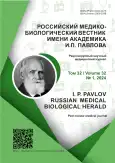Vascular Stiffness in Senile Patients with Chronic Heart Failure
- Authors: Grachev D.S.1, Petrov V.S.1, Namazova K.I.1, Maksyakova T.A.1, Tokareva V.I.1
-
Affiliations:
- Ryazan State Medical University
- Issue: Vol 32, No 1 (2024)
- Pages: 65-72
- Section: Original study
- URL: https://bakhtiniada.ru/pavlovj/article/view/254756
- DOI: https://doi.org/10.17816/PAVLOVJ375266
- ID: 254756
Cite item
Abstract
INTRODUCTION: The study of vascular stiffness is a method of assessing the risk of cardiovascular diseases. One of methods of assessing arterial stiffness is theсardio-ankle vascular index (CAVI), which reflects the extent of structural lesion of vessels. This index has prospects in application for studying vascular stiffness in senile individuals with chronic heart failure (CHF) to identify new predictors of the cardiovascular risk.
AIM: To study the parameters of vascular stiffness (cardio-vascular and ankle-brachial indices) in senile patients (75–89 years) with CHF using the volume sphygmography method.
MATERIALS AND METHODS: The study included 120 patients (87 women and 33 men) with CHF of senile age (mean age 81.3 ± 4.2 years). In all patients, the electrocardiography and sphygmography data were analyzed with assessment of the CAVI and ankle-brachial index.
RESULTS: In patients with IV functional class (FC) CHF, the highest CAVI was found on the right exceeding the parameters of II FC CHF and III FC CHF groups by 0.57 and 1.02 units, respectively (p < 0.05). The CAVI on the left in patients with IV FC CHF was higher in comparison with II FC CHF and III FC CHF groups by 0.47 and 0.6 units, respectively. There were also identified correlation relationships of vascular stiffness with the age of patients, functional class of chronic heart failure and echocardiographic parameters: left ventricle ejection fraction, left ventricle end-diastolic diameter, left-ventricle end-systolic diameter (p < 0.05).
CONCLUSION: The cardio-ankle vascular index can be used to assess vascular stiffness in senile patients with CHF and can help determine the risk of cardiovascular diseases. Further studies are needed on a larger sample of patients.
Full Text
##article.viewOnOriginalSite##About the authors
Dmitriy S. Grachev
Ryazan State Medical University
Author for correspondence.
Email: dmitrygrachev@internet.ru
ORCID iD: 0009-0002-5972-5631
Russian Federation, Ryazan
Vadim S. Petrov
Ryazan State Medical University
Email: dr.vspetrov@gmail.com
ORCID iD: 0000-0001-8631-8826
MD, Dr. Sci (Med.), Associate Professor
Russian Federation, RyazanKamila I. Namazova
Ryazan State Medical University
Email: kamila.namazowa@yandex.ru
ORCID iD: 0000-0001-6771-7151
Russian Federation, Ryazan
Tat'yana A. Maksyakova
Ryazan State Medical University
Email: tanyamaksyakova@gmail.com
ORCID iD: 0000-0003-3637-7435
Russian Federation, Ryazan
Viktoriya I. Tokareva
Ryazan State Medical University
Email: vikusyaTok@mail.ru
ORCID iD: 0000-0003-2609-9937
Russian Federation, Ryazan
References
- Barodka VM, Joshi BL, Berkowitz DE, et al. Review article: implications of vascular aging. Anesthesia & Analgesia. 2011;112(5):1048–60. doi: 10.1213/ANE.0b013e3182147e3c
- Fomina OA, Yakushin SS. Evaluation of endothelial function, of elasticity of vessel wall and their influence on one-year prognosis of patients with myocardial infarction with obstructive and non-obstructive coronary arteries. I. P. Pavlov Russian Medical Biological Herald. 2020;28(4): 488–96. (In Russ). doi: 10.23888/PAVLOVJ2020284488-496
- Kalinin RE, Suchkov IA, Mzhavanadze ND, et al. Dysfunction in muscular dystrophies. Nauka Molodykh (Eruditio Juvenium). 2021;9(2):326–34. (In Russ). doi: 10.23888/HMJ202192326-334
- Ankle Brachial Index Collaboration; Fowkes FGR, Murray GD, Butcher I, et al. Ankle brachial index combined with Framingham Risk Score to predict cardiovascular events and mortality: a meta-analysis. JAMA. 2008;300(2):197–208. doi: 10.1001/jama.300.2.197
- Weatherley BD, Nelson JJ, Heiss G, et al. The association of the ankle-brachial index with incident coronary heart disease: the Atherosclerosis Risk In Communities (ARIC) study, 1987–2001. BMC Cardiovasc Disord. 2007;7:3. doi: 10.1186/1471-2261-7-3
- Vasyuk YuA, Ivanova SV, Shkolnik EL, et al. Consensus of Russian experts on the evaluation of arterial stiffness in clinical practice. Cardiovascular Therapy and Prevention. 2016;15(2):4–19. (In Russ). doi: 10.15829/1728-8800-2016-2-4-19
- Aboyans V, Criqui MH, Abraham P, et al. Measurement and interpretation of the ankle-brachial index: a scientific statement from the American Heart Association. Circulation. 2012;126(24):2890–909. doi: 10.1161/CIR.0b013e318276fbcb
- Cecelja M, Chowienczyk P. Role of arterial stiffness in cardio- vascular disease. JRSM Cardiovasc Dis. 2012;1(4):cvd.2012.012016. doi: 10.1258/cvd.2012.012016
- Wilkins JT, McDermott MM, Liu K, et al. Associations of noninvasive measures of arterial compliance and ankle-brachial index: the Multi-Ethnic Study of Atherosclerosis (MESA). Am J Hypertens. 2012;25(5): 535–41. doi: 10.1038/ajh.2012.13
- Costantino S, Paneni F, Cosentino F. Ageing, metabolism and cardio-vascular disease. J Physiol. 2016;594(8):2061–73. doi: 10.1113/JP270538
- Budoff MJ, Alpert B, Chirinos JA, et al. Clinical Applications Measuring Arterial Stiffness: An Expert Consensus for the Application of Cardio-Ankle Vascular Index. Am J Hypertens. 2022;35(5):441–53. doi: 10.1093/ajh/hpab178
- Park JB, Sharman JE, Li Y, et al. Expert Consensus on the Clinical Use of Pulse Wave Velocity in Asia. Pulse (Basel). 2022;10(1–4):1–18. doi: 10.1159/000528208
- Zairova AR, Rogoza AN, Oshchepkova EV, et al. Contribution of cardio-ankle vascular index to prediction of cardiovascular events in the adult urban population: data from the ESSE-RF study (Tomsk). Cardiovascular Therapy and Prevention. 2021;20(5):2967. (In Russ). doi: 10.15829/1728-8800-2021-2967
- Vlachopoulos C, Xaplanteris P, Aboyans V, et al. The role of vascular biomarkers for primary and secondary prevention. A position paper from the European Society of Cardiology Working Group on peripheral circulation: Endorsed by the Association for Research into Arterial Structure and Physiology (ARTERY) Society. Atherosclerosis. 2015;241(2):507–32. doi: 10.1016/j.atherosclerosis.2015.05.007
- Townsend RR, Wilkinson IB, Schiffrin EL, et al. Recommendations for Improving and Standardizing Vascular Research on Arterial Stiffness: A Scientific Statement From the American Heart Association. Hypertension. 2015;66(3):698–722. doi: 10.1161/HYP.0000000000000033
- Saiki A, Ohira M, Yamaguchi T, et al. New Horizons of Arterial Stiffness Developed Using Cardio-Ankle Vascular Index (CAVI). J Atheroscler Thromb. 2020;27(8):732–48. doi: 10.5551/jat.RV17043
- Boutouyrie P, Chowienczyk P, Humphrey JD, et al. Arterial Stiffness and Cardiovascular Risk in Hypertension. Circ Res. 2021;128(7):864–86. doi: 10.1161/CIRCRESAHA.121.318061
- Namba T, Masaki N, Takase B, et al. Arterial Stiffness Assessed by Cardio-Ankle Vascular Index. Int J Mol Sci. 2019;20(15):3664. doi: 10.3390/ijms20153664
- Abdullah N, Blin JA, Arifin ASK, et al. Cardiovascular risk prediction with cardio-ankle vascular index in the malaysian cohort study. Curr Probl Cardiol. 2023;49(3):102192. doi: 10.1016/j.cpcardiol.2023.102192
- Tomiyama H. Cardio-ankle vascular index in the management of hypertension. Hypertens Res. 2023;46(2):537–8. doi: 10.1038/s41440-022-01057-1
Supplementary files







